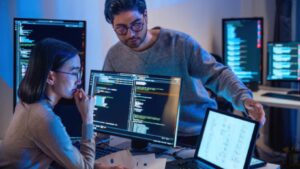
Learning forex trading can be rewarding, but it requires a solid understanding of the market and strategies to succeed. Among the many skills a trader must develop, risk management is paramount. Proper risk management can mean the difference between consistent profits and substantial losses.
Keep reading to discover how to master forex trading through effective risk management.
Understanding Your Risk Tolerance
Before diving into the forex market, take a moment to assess your risk tolerance. This isn’t just about how much money you can afford to lose, but also about your emotional comfort level with potential losses in forex trading. Honest self-evaluation here will serve as the bedrock of your trading strategy.
Here are some factors to consider when evaluating your risk tolerance:
Investment Goals
Are you saving for retirement or a short-term goal? Long-term goals often allow for a higher risk tolerance. Investors saving for retirement can potentially ride out market fluctuations, whereas someone saving for a down payment on a house might need a more conservative approach.
FinancialSituation
Can you absorb potential losses without jeopardizing your financial stability? A stable financial situation allows you to withstand potential losses without significant stress. A lower risk tolerance might be wise if a loss would cause major hardship.
Emotional Temperament
How do you react to seeing your capital decrease? Forex trading can be fast-paced, and emotions can run high. If you tend to make impulsive decisions when faced with losses, a lower risk tolerance strategy can help you stay disciplined.
By carefully considering these factors, you can establish a risk tolerance level that aligns with your financial goals and emotional well-being. This will guide you in developing a trading strategy that utilizes calculated risks you’re comfortable with while offering growth potential.
Developing a Trading Plan
A well-defined trading plan isn’t just a recommendation—it’s essential for navigating the forex market with focus and discipline. Think of it as your personal roadmap, outlining your entry and exit strategies, risk management techniques, and overall trading approach.
Here are the key elements to incorporate:
Market Analysis
Choose your preferred method of analyzing the market. Will you focus on economic data through fundamental analysis, or use technical analysis with price charts and indicators like candle stick patterns?
Trading Strategy
Define your trading style. Are you interested in short-term scalping or capturing medium-term trends with swing trading?
Money Management
Determine a set percentage of your capital to allocate per trade. This helps ensure you don’t overexpose yourself to risk on any single position.

It is crucial to regularly review and refine your trading plan. As market conditions evolve and your experience grows, so should your plan. This ensures it remains aligned with your goals and risk tolerance.
Position Sizing
Position sizing determines how much capital you risk on each trade. It’s a fundamental aspect of risk management that directly impacts your potential profit or loss.
Here’s how to approach position sizing effectively:
Risk A Small Percentage Per Trade
A common guideline is to risk no more than 1-2% of your total account capital per trade. This approach helps you weather losing streaks and stay in the game for the long haul. Even a series of small losses won’t wipe out your account entirely.
Consider Account Size
The size of your trading account can influence your risk percentage. Larger accounts have more flexibility and can potentially tolerate slightly higher risk percentages per trade than smaller accounts.
Account For Volatility
Not all currency pairs are created equal. Volatile pairs experience larger price swings, so it’s wise to use a smaller position size for these to minimize potential losses. Conversely, less volatile pairs might allow for a slightly larger position size.
By following these principles and carefully calculating your position size, you ensure you’re not putting a significant portion of your capital at risk on any single trade. This measured approach helps you manage risk effectively and protects your hard-earned money.
Protective Stop-Loss Orders
Stop-loss orders are more than just insurance against potential losses in forex trading; they’re a fundamental risk management tool. Think of them as automatic safety nets that limit your downside by exiting your position when the price reaches a predetermined level. Here’s how to use stop-loss orders effectively:
Set Realistic Stop-Loss Levels
Don’t place them too tight, expecting to catch every single price movement. The forex market is inherently volatile, and a stop-loss that’s too close to the entry price could trigger prematurely due to normal market fluctuations.
Base Them On Your Analysis
Your stop-loss should be strategically placed based on your technical or fundamental market analysis. For example, a technical analyst might use support or resistance levels to determine an appropriate stop-loss, while a fundamental trader might base it on key economic data releases.
Discipline Is Key
Once you’ve set your stop-loss, stick to it. The temptation to adjust it after entering a trade to avoid a loss can be strong, but doing so undermines the order’s effectiveness. Letting your emotions dictate your stop-loss placement can lead to larger losses.

By incorporating stop-loss orders into your trading strategy, you gain peace of mind and protect your capital during periods of market volatility. They help ensure that a single losing trade doesn’t wipe out your entire account.
Conclusion
Forex trading can be a tempting path to financial gain, but success hinges on a disciplined approach to prioritizing risk management. You lay a strong foundation by assessing your risk tolerance and crafting a trading plan that aligns with your goals and comfort level. Remember, effective risk management isn’t about eliminating losses entirely; it’s about strategically limiting them and protecting your capital. Through practices like proper position sizing and utilizing stop-loss orders, you can navigate the forex market with greater confidence and make informed decisions that pave the way for long-term success.














